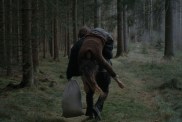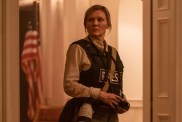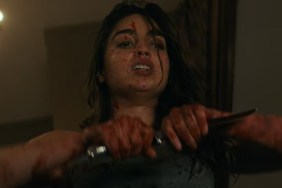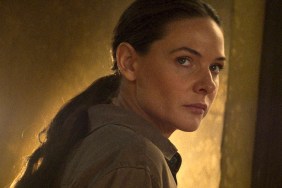While to most people he’ll always be known as one half of “Bill & Ted” or as Neo from “The Matrix” movies, it’s become clear in recent years that actor Keanu Reeves has interest in doing more work behind the camera, and in the Christopher Kenneally-directed doc Side by Side, which has had a successful festival run over the last few months, he gets to do a little bit of both.
The movie arose out of the question of why so many filmmakers have stopped shooting on film and have taken up the cause begun by digital filmmaking pioneers to make the digital the new industry standard. Kenneally and Reeves got a long list of superstar directors to talk to them, names like George Lucas, James Cameron, Christopher Nolan, Martin Scorsese, David Fincher and Danny Boyle, as well as many cinematographers and technicians who we rarely get to hear from. But Side by Side doesn’t just cover the technical aspects of why filmmakers prefer digital over film or vice versa, but also the artistic aspects of using one or the other. (You can read our review here.)
ComingSoon.net got on the phone with Reeves last week to talk about this intriguing film that any person who takes movies seriously should try to catch even if it’s just to see so many great filmmakers in the same place talking about their craft.
We didn’t get that much time with Reeves but we did get to chat briefly about his directorial debut Man of Tai Chi and to ask about Passengers, the sci-fi project he developed with Prometheus co-screenwriter Jon Spaihts.
ComingSoon.net: I’ve seen the movie a couple of times going back to Tribeca and I think the most obvious question is how you started going down the road to make this movie? Was this something you came up with or something Christopher suggested doing?
Keanu Reeves: Yeah, Chris and I were working together on a film called “Henry’s Crime,” and we were involved in post–he was a post supervisor–and during the process of doing that, we were in this part of filmmaking called DI, the digital intermediate, where you’re color correcting the image. We basically had the digital image and the photochemical image on the screen side by side. In doing this process, I was thinking that maybe this might be the end of film. It was shot on film, but it was being digitized so that it could be projected digitally. This is going to be the end of film. I kind of had this question, and I asked Chris if he wanted to make a documentary. He had made a documentary before, and he said, “Yes.” We both kind of went on this expedition to answer these questions of “Where are we now? Where have we come from? Where might we be going, and the impact of digital cinema?”
CS: It’s funny because days after I saw this at Tribeca, I was at CinemaCon and Tom Rothman (CEO of Fox Filmed Entertainment) announced that they were going to stop shipping film to theaters for their movies, so did you get the impression that’s where things were going?
Reeves: Yeah, I mean, when we interviewed him for the documentary, he said he thought five years, so I guess he’s ahead of his schedule. (Laughs)
CS: It’s pretty scary when you think about it.
Reeves: Yeah, he thought five years photochemical would not be, would at least not be part of his business.
CS: When you and Christopher decided to make this movie, what was your approach to getting people to talk? You obviously knew the Wachowskis already so did you go to the people you knew first? How did you go about approaching the people to interview?
Reeves: Well, we first put our team together, so we met with a producer, Justin Szlasa. He had a cinematographer, Chris Cassidy. Once we had that together, then we kinda started to look at, “Okay, well, where do we start?” We thought we’d start with cinematographers, so we went to a film festival in Poland called Camerimage, and we started to basically just say, “Hi, we’re here doing a documentary. Do you want to talk to us?” I had worked with some of the cinematographers there. This was in 2010 and people wanted to speak about this subject, and the end of film, the impact of digital cinema, so we started there. Then we kind of started to look back at films and like, “Okay, what were the first cameras?” We kind of started with the camera, and who had the camera. Well, then we should talk about editing, and Chris Kenneally wanted to basically follow the work flow of the movie, so we kind if addressed that and started looking at the impact of digital through all of these. By looking at digital, you have to look at photochemical, and that’s why it’s called “Side by Side.”

CS: When did you guys decide that you would be doing the interviews yourself? That adds another layer of scheduling in terms of getting you to where they are.
Reeves: Yeah, it’s very personal, this documentary, in a sense, so I wanted to be part of it, and I wanted to get the answers. These questions that I ask are my questions and it’s Chris’s interest. Chris and I wanted to make a film that would be interesting to the specialist, but more importantly also the general audience, sort of a movie about movies. Hopefully when people see this, it’s going to deepen the appreciation. It’s kind of like a behind the scenes in how did they make it? How do they do it? For me, it was reaching out personally to other artists to try, and Chris, reaching out to people. So I would reach out, and then the documentary would reach out to see if anybody was interested in speaking to us.
CS: How did you guys decide which actors to approach? You have Greta Gerwig, who is an interesting choice, as well as John Malkovich, so how did you know which actors you wanted to include in the conversation?
Reeves: Yeah, I mean, we didn’t have an outline persé, when we started. We didn’t say, “Okay, well, these are the answers and this is the history of this.” It started with just a general question. Anthony Dod Mantle was an example of how it kind of organically (grew)
“Early DV, what were some of the more impactfuloh, right, The Celebration. Well, who shot that? Anthony Dod Mantle. Well, we have to talk to Anthony. Oh, wait, wait, wait, Anthony worked with Danny Boyle. Right, that’s ’28 Days Later’ right? Well, that’s also Slumdog Millionaire’ (laughs) so then we have to go talk to them.” Then I was like, “Well, early digital video, like who is doing that?” And then getting into InDigEnt and Chuck & Buck.’ We had to kind of narrow it down, because we could’ve spoken about digital in China or India or Europe, but we kind of kept it Hollywood-centric in a way, whether it was independents and the relationship to Hollywood, or the development of the technology. Then when you get into editing, George Lucas is the best choice to talk about that, so then we just kept going – ILM, Dennis Murren, the first digital shot. We started to get these landmarks of, “Okay, well, what’s the first digital shot? Who made the first digital movie? What had impact?” So we just started to follow the story, until we give an overview of a really broad subject.
CS: It’s really thorough and I’m surprised you were able to fit so much into a relatively short 98-minute movie and there were so many different ways to approach it. How much time did you spend with people like George Lucas or Danny Boyle? How much time did they give you?
Reeves: You know, we really depended on people’s schedules. We really just wanted to make it easy for people. “So what can you give us? When can you do it? We’ll come to you. Just let us know and please don’t say no.” (laughs) Christopher Nolan was great. He spoke to us during lunch break while he was shooting the newest “Batman” film. So we were really fortunate, and it was a great experience.
CS: You must have made this over a couple of years while making a number of movies yourself because your looks change throughout the movie.
Reeves: Yeah, our hair grows, we get hair cuts
(Laughs)
CS: You don’t really see many docs like that where you can really tell it was made over a substantial amount of time.
Reeves: Yeah, we did our interviews I guess over the course of pretty much a year. Over a year, a year and something, 14 months, yeah, about a year.
CS: One of the people I was surprised you didn’t get–I’m not sure if you tried or not–is Michael Mann, because he’s a filmmaker who really has made a very drastic transition to digital.
Reeves: Yeah, it’s just there’s a lot of people that we could’ve spoken to and didn’t have the chance too. Absolutely. I mean, him and (cinematographer) Paul Cameron did some of the early development stuff on “Collateral.” But yeah, there’s lots of people that we could have and should have, there’s a lot of that.
CS: Who would you think is the person who should see the movie? Is it for film students and people know the process or some aspect of it?
Reeves: I don’t know if they need to know. I think if you like movies, I think this would be really interesting. Like I said, it’s like a behind the scenes and a how-to and how do they do it with some really great artists and passionate people speaking passionately about their passions. (Laughs) I think one of my hopes for it is that as a general audience or a specialist, it’s just that you can gain a deeper appreciation for movies – you’ll be able to see them in a different way. You’ll know different things, and maybe that’ll help to maybe make moviegoing more enjoyable. I mean, we do interviews, and someone in this film is talking about something, then we tried to illustrate it, whether it’s through an image or an animation, to kind of give examples, yeah.

CS: Sure, it’s definitely thrilling to hear these filmmakers talk about such an important aspect of filmmaking. So what else do you have next? Do you have other films you’re producing or want to direct?
Reeves: Right now, the last film was I just finished doing principal photography on a kung fu movie. I directed a Chinese kung fu movie – Chinese, Mandarin and Cantonese and English. We just finished filming, so I just got back from China and we’re in post.
CS: That’s interesting that you’re doing so much stuff in foreign languages because I remember that “47 Ronin” you actually filmed both in Japanese and English? Have you generally been learning these languages to do these?
Reeves: No, it just kind of happened. I don’t know how it happened, but that’s where the river has taken me. Yeah, “47 Ronin” I hope will come out next year, and I’m really looking forward to that and that’s kind of it.
CS: I had a chance to talk to Jon Spaihts a couple of months ago, and we talked about “Passengers.” It sounded like a real cool project so has there been any movement on that since “Prometheus” came out? Are people a little more interested in that?
Reeves: Yeah, “Passengers” is a great project. I hope we get to make it. Yeah, starting making movies sometimes has its challenges, and right now we’re trying to answer the questions of how can we make this movie? It’s just a really ambitious film production-wise, and it’s just about raising enough resources to try and be able to make it. So, but I’m glad, yeah, Spaihts is a great writer, and “Passengers” is a great project.
Side by Side opens in Los Angeles and other select cities on Friday, August 17, and then is available On Demand starting August 22.









